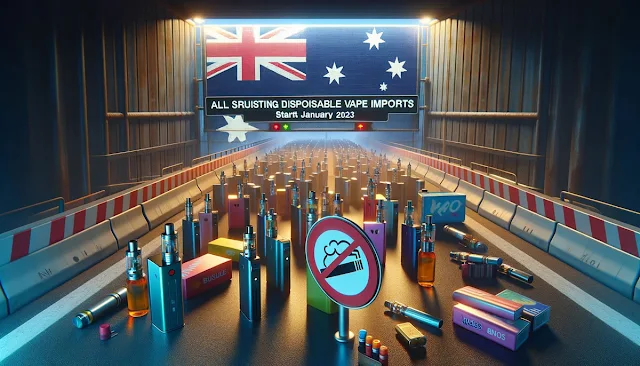Australia is set to ban the import of disposable vapes from January 1st, 2024 in an effort to protect young people from nicotine addiction. The decision comes amidst growing concern that vapes are acting as a gateway for teenagers to start smoking.
Why Target Disposable Vapes?
Disposable vapes have come under particular scrutiny in Australia due to their compact size, discreet appearance, and appealing flavors. Their accessibility and affordability have made them hugely popular among high school and college students looking for a nicotine fix.
As Health Minister Mark Butler explained, "Disposable vapes have been deliberately designed to avoid detection and enable easy concealment by young people at school or at home." Their colorful, playful marketing has also been called out as a cynical ploy by the vaping industry to "recruit a new generation to nicotine addiction."
With smoking still the leading cause of preventable death in Australia, responsible for around 20,000 fatalities annually, officials are determined to prevent more young people going down that path. Vaping has exploded in popularity, with around 25% of 18-24 year olds now using e-cigarettes. Evidence shows vapers are three times more likely to transition to smoking tobacco. Shutting off access is seen as key.
Import Bans and Tighter Regulation
The initial ban on importing disposable vapes is just the first phase of a concerted government effort to clamp down on vaping and protect public health. From March 2024, all vape products regardless of nicotine content will be prohibited from entering the country.
Strict new vaping regulations will also take effect during 2024, spanning manufacturing, advertising, sales and usage. For example, vape liquid strengths will be capped, flavors restricted, and plain packaging mandated. General online and in-store promotion of vaping will be banned entirely.
The only vapes still permitted will be "therapeutically approved" products available by medical prescription. Doctors will be able to prescribe vapes as smoking cessation aids from January 2024. Even these products will still face advertising restrictions and regular nicotine content reductions however.
$340M War Chest to Beat Smoking and Vaping
Alongside legislation to curb vaping, the Australian government has allocated over $500M AUD to fund a four year health campaign against smoking and youth vaping. The national program includes:
- Expanded cessation services like quitline support and nicotine replacement therapy
- Public education drives highlighting vaping risks
- Clinical guidance for medical professionals
- Commissioning further research
"We want to help citizens make informed choices," said Minister Butler, "but we also need to protect young people from an industry deceiving them for profit." The government hopes that smoking rates can be driven down to less than 10% of the adult population by 2030 through this "whole of population" strategy.
Penalties Target Sellers Rather Than Vape Users
The incoming vape bans predominantly target sellers and importers rather than end users. When quizzed about penalties for citizens caught vaping prohibited products, Butler confirmed "the focus is on vendors" not individual vapers.
He acknowledged that many people had initially understood vaping as a smoking cessation aid before the youth addiction crisis became apparent.
Butler wants to avoid the "heavy handed authoritarian approach" of some countries that have criminalized vape possession. Education and smoking cessation support will instead be prioritized for citizens over punishment. However the legal sale or import of banned vaping products will carry severe penalties in Australia from 2024 onward.
Global Trends: New Zealand, Malaysia and Beyond
Australia is not alone in wanting to get control over youth vaping rates. Neighboring New Zealand has already banned most flavored disposable vapes to try to curb teenage usage. And Malaysia controversially ended its blanket vaping prohibition in 2022, instead legalizing and taxing vape products to raise revenue and improve regulatory oversight.
The USA, home to market leader Juul, has seen individual states introduce flavor bans amidst growing concern over youth vaping addiction. Regulators have also forced certain major manufacturers to remove non-tobacco flavored products from sale nationally.
With disposable vapes only becoming widely available internationally in the last 3-4 years, governments are scrambling to catch up. France will also outlaw disposable models for instance. But views differ wildly on vaping legislation globally, with Australia adopting one of the most hardline stances.
The Road Ahead for Australian Vapers
So for Australian vapers, change is coming. Disposable vape access will be cut entirely during 2024. And all vape products face major restrictions or prohibition from March 2024 onwards, apart from medically approved options.
With government policy firmly set and penalties severe for rogue sellers, the days of easy, legal access to imported mass market vapes in Australia are numbered. Public health is being prioritized over industry growth or vaping freedoms.
Most current vapers will need to either quit or carefully transition to regulated medical vaping products obtained through their doctor. The hope is that smoking and youth vaping rates will plummet as a result, preventing thousands of future cancer deaths. But some vaping advocates argue that exclusion and "prohibition 2.0" may instead fuel a growing black market.
One thing is clear - change is here and the government is committed to decisive action. Exactly what impact that has on Australian smoking and vaping trends long-term remains to be seen.
